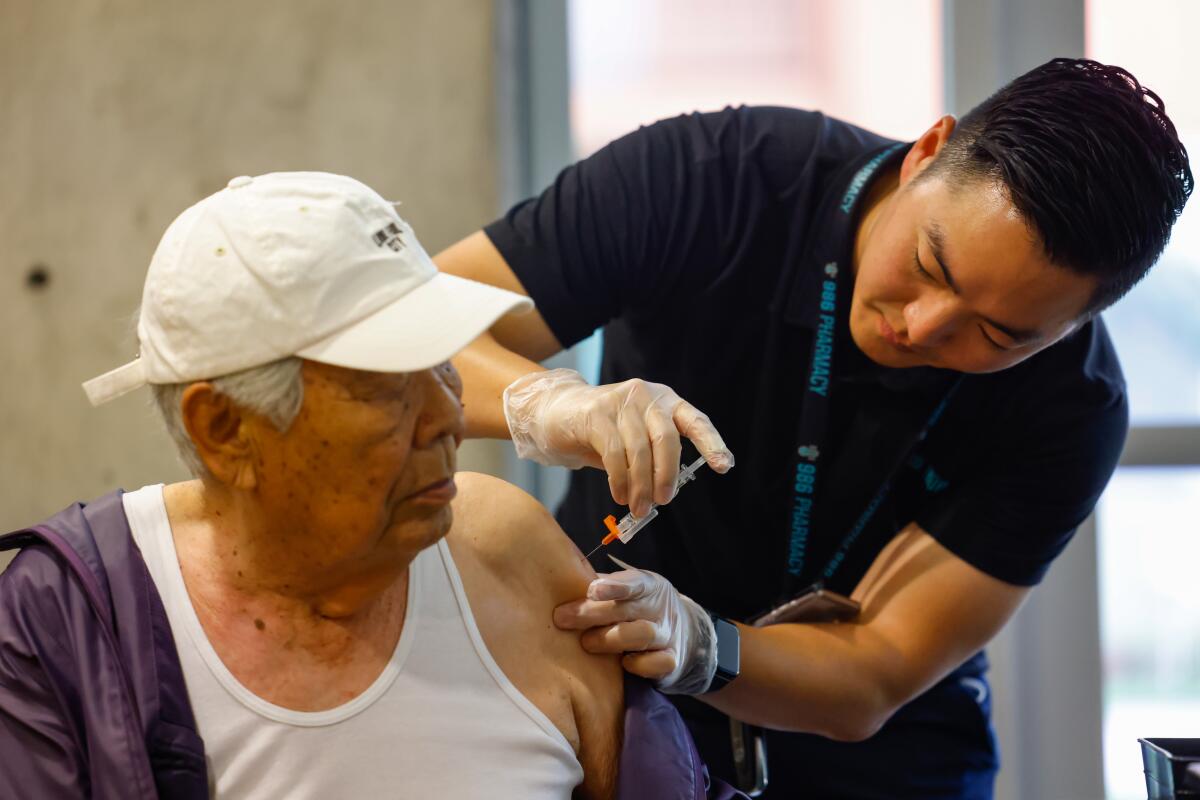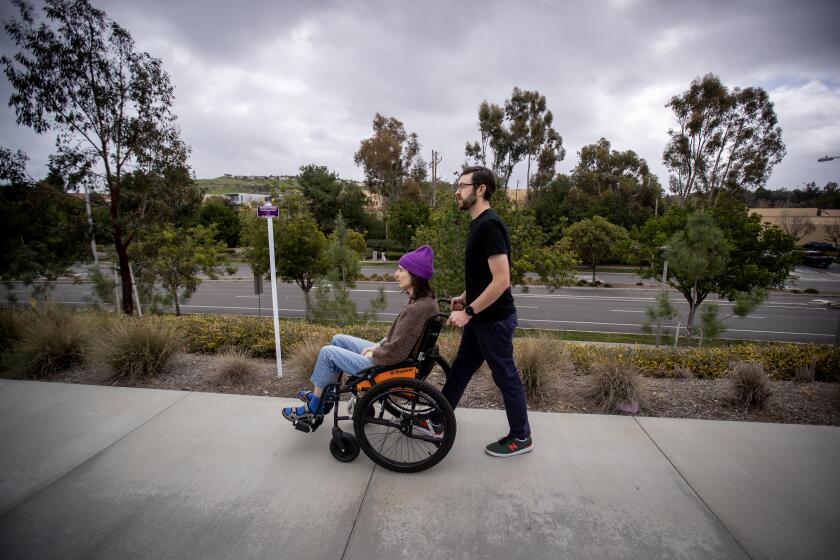As COVID wave wallops California, new vaccines arrive this week. Will it be a turning point?

- Share via
New COVID-19 vaccines are expected to be available as soon as this week, a promising development amid California’s potent and enduring summer wave of the disease.
The U.S. Food and Drug Administration authorized the distribution of the updated Moderna and Pfizer COVID-19 vaccines for the 2024-25 season on Thursday. And in preparation for winter, when COVID typically surges again, federal officials said Americans will soon be able to register to receive four free tests in the mail.
Major retailers — including CVS, Walgreens, Rite Aid, Ralphs, Vons, Pavilions, Albertsons and Safeway — are already accepting appointments for the new COVID-19 vaccines, or soon will. Kaiser Permanente expects to begin administering the shots by mid-September, and possibly earlier in some locations.
The new vaccines have been reformulated in hopes of providing optimal protection against the most commonly circulating coronavirus strains, a process that can be comparable to development of the annual flu shot.
Pfizer and Moderna are set to begin shipping millions of doses. A third U.S. manufacturer, Novavax, expects its updated vaccine version to be available a little later.
The arrival of the latest vaccines comes amid a surprisingly powerful summer COVID wave — the strongest in terms of infections since 2022. Increased circulation of new hyperinfectious subvariants has sickened many Americans, ruined vacations and weddings and forced people to miss work.
Coronavirus levels in wastewater are considered “high” or “very high” in 45 states, including California, as well as in the District of Columbia. Coronavirus sewage levels were considered “moderate” in Michigan, New Jersey, Vermont and West Virginia; no data was available for North Dakota.
Earlier this year, some of the coronavirus subvariants that succeeded last winter’s dominant strain were collectively nicknamed FLiRT — a play on some of the technical terms for their mutations. That group included a strain officially known as KP.2.
A successor subvariant, KP.3, had a different mutation and so was nicknamed FLuQE — pronounced “fluke.” An even more contagious subvariant, KP.3.1.1, had a mutation that was deleted, giving it the unofficial moniker deFLuQE, or “de-fluke.”
For most people, September and October are the best months to get vaccinated against both COVID-19 and flu, according to the U.S. Centers for Disease Control and Prevention. Everyone age 6 months and older should receive updated COVID-19 and flu vaccines, and can get both during the same visit, the CDC said.
“The important part is getting it done,” CDC Director Mandy Cohen said at a briefing. “If September, from a calendar perspective, works better for folks, great. October gets you closer to the to the winter season. But the important part is getting it done.”
COVID’s spread is being aided by people who are still going to work or traveling while sick. Doctors say it’s important for people who are sick to avoid putting others at risk.
Dr. Cohen said Friday that peak winter hospitalizations for COVID-19, flu and respiratory syncytial virus, or RSV — a triple-header that has strained hospitals in the past — are expected to be similar to last year’s, or even slightly improved. But that forecast could prove overly optimistic, she said, if some assumptions end up being wrong — for example, if fewer people get vaccinated than expected.
COVID-19 continues to circulate at a very high level nationally and in California.
The rate at which coronavirus tests are coming back positive continues to rise. For the week that ended Aug. 14, 14.4% of reported coronavirus tests were positive in California. That’s higher than the peaks seen last summer and winter, and up from about 11% a month ago.
But depending on the region, “I think we are potentially seeing some indication of a plateauing of the summer increase in COVID-19,” said Dr. Demetre Daskalakis, who heads the CDC’s National Center for Immunization and Respiratory Diseases. Still, “we’re not out of the woods yet,” he added.
With COVID numbers in California spiking this summer, experts are warning the new FLiRT strains driving the spread could be around for some time.
There are now 26 states, including California, where COVID-19 is projected to be “growing” or “likely growing.” That’s down from 44 states in those categories about six weeks ago, according to the CDC.
There are initial signs that the summer surge may be starting to peak in some areas, including Los Angeles County, although trends won’t be clear until there are a few weeks of sustained declines.
For the week that ended Aug. 18, there were an average of 421 coronavirus cases a day in L.A. County. The week prior, there were 484.
Out of all emergency department encounters countywide for the week that ended Aug. 18, 3.9% were related to the coronavirus, down from the previous week’s 4.3%. Last summer’s peak was 5.1%.
COVID hospitalizations are essentially flat. For the week that ended Aug. 17, a daily average of 478 coronavirus-infected people were in hospitals in L.A. County. The week before, there were 481. Last summer’s peak was 620.
“Given that this is just one week’s data, it’s too soon to know if these declines will continue or indicate if transmission has plateaued or peaked,” the L.A. County Department of Public Health said in a statement to The Times.
Coronavirus levels in the county’s wastewater are up, but that metric has a longer lag time than other indicators. For the 10-day period that ended Aug. 10, coronavirus levels in L.A. County sewage were measured at 87% of last winter’s peak. That’s up from the 10-day period that ended Aug. 3, when coronavirus levels were at 76% of the winter peak.
Overall, coronavirus levels in California’s wastewater have been largely flat in recent weeks.
In general this summer, emergency room visits, hospitalizations and deaths from COVID have been rising, but, fortunately not as sharply as during earlier waves of the pandemic.
“While the COVID virus continues to mutate and change faster than the flu virus, our underlying immunity from prior vaccines and prior infections provides some protection,” Cohen said. “But we know that protection decreases over time, and certain groups continue to be at higher risk from COVID and other viruses, and we need to continue to protect ourselves and our loved ones.”
COVID remains more of a threat than the flu.
“In terms of what is hospitalizing more folks and what is killing more folks, COVID continues to be a more dangerous virus than flu,” Cohen said.
Nationally, at least 50,000 COVID-19 deaths have been reported since October, compared with at least 25,000 flu deaths. CDC estimates on flu deaths will be updated later this year.
That’s why it’s so important that people get freshly vaccinated heading into fall, doctors say. Those at highest risk include seniors and immunocompromised people who haven’t been vaccinated against COVID-19 in more than a year.
California’s summer COVID surge has proved to be particularly strong and enduring, as it storms to levels not seen in summertime in over two years.
As of the end of last winter, just 29% of seniors nationally had received the previous COVID-19 vaccination, according to data on a subset of Medicare beneficiaries. As of July 31, 37% of California seniors had received at least one dose of that vaccine, which first became available last September.
It’s not just seniors who can be at risk. “Remember ... 80% of the adults in the country have some sort of underlying condition that could put them at some sort of increased risk,” Cohen said.
And the very young can be vulnerable, too.
“When we look at who went to the emergency room for COVID, we actually saw that it was highest for those under the age of 5,” Cohen said of this summer’s wave. “We can’t forget that at every age group, there are risks, including our young children.”
Each new infection also carries the risk of long COVID — in which symptoms, sometimes severe enough to be debilitating, can emerge, persist, resolve and reemerge over a period of weeks, months or years.
“I have a tremendous empathy, having seen people struggle with long COVID in their 30s and 40s, people who you might think were otherwise low-risk,” Dr. Peter Marks, the FDA’s vaccine chief, said Friday. There are estimates that getting vaccinated can reduce the risk of developing long COVID by 50%, Marks said.
The prevalence of long COVID has declined since the start of the pandemic, a new study found, but each new infection carries a risk of developing enduring symptoms.
People who might want to consider getting the updated COVID-19 vaccine as soon as possible include those who are older or immunocompromised and haven’t been vaccinated in more than a year. Those groups are at highest risk for being hospitalized with COVID-19 now, said Dr. Peter Chin-Hong, a UC San Francisco infectious diseases expert.
“I would love them to get protected, if they would want to go and get the vaccine now,” Chin-Hong said.
Another consideration is whether you are about to go on a trip, or planning an unmissable event or experience.
“Right now, if they want to prevent infection, it’s a good time to get something, because it’s so closely matched to what’s going around,” Chin-Hong said of the new vaccine.
Getting the COVID-19 vaccine now will offer good protection against severe disease through the winter, he said.
California is in the middle of its worst summer COVID wave since 2022, with virus levels and infections surging across the state.
Chin-Hong said the best protection against infection is within roughly six to eight weeks after getting vaccinated — though that window can be wider if the vaccine is a close match to circulating subvariants.
Marks said timing is a matter of personal choice, but he already has his own vaccine appointment scheduled.
“Getting vaccinated now probably gives you the maximum amount of protection that you can get against what’s currently circulating, and that will last for several months at least,” he said.
The many people who have recently had COVID-19 may wait for as long as three months to get vaccinated, according to the CDC, as an infection in many cases imparts strong, if fleeting, protection against the virus — at least for a few weeks or months. But there are some reasons to get the vaccine soon after an illness, such as if you, a family member or household member are at high risk of severe COVID illness, or if transmission is elevated where you live.
And for people who just got vaccinated against COVID over the summer with the older formula, they can wait two months before getting the updated one, Chin-Hong said, “so October would be fine for them.”
“To me, the sweet spot is always October,” he said, as it’s closer to the peak of the late fall and winter respiratory virus season, as well as major holidays like Thanksgiving, Christmas and the New Year.
Doctors urge people who are experiencing respiratory problems to see a medical professional who can check their symptoms and test to determine what their illness is.
Another measure health officials recommend, particularly when transmission is elevated, is testing when you feel sick, or before events — especially if medically vulnerable people are going to attend.
Starting in late September, free COVID tests from the federal government will be available for order at covidtests.gov.
The CDC has also simplified recommendations on who should get vaccinated for respiratory syncytial virus, or RSV. The agency now recommends that all adults age 75 and up, as well as those 60 to 74 at increased risk for severe RSV disease, get vaccinated. Those risk factors include having chronic heart or lung disease, a weakened immune system, certain medical conditions like severe obesity and severe diabetes, and living in a nursing home.
The RSV vaccine is not annual, meaning people who got one last year don’t need to get another one at this time, the CDC said. Those who didn’t can get it on the same visit as their flu and COVID shots.
An RSV vaccine is also available for expectant mothers at weeks 32 to 36 of pregnancy to pass protection on to their fetuses. An RSV antibody is available for babies and some young children, too.
“All of these vaccines prevent the worst of these infections,” Cohen said. “That means fewer visits to the doctor, fewer hospitalizations, and more time to enjoy the fall and winter with family and loved ones.”
More to Read
Sign up for Essential California
The most important California stories and recommendations in your inbox every morning.
You may occasionally receive promotional content from the Los Angeles Times.





















